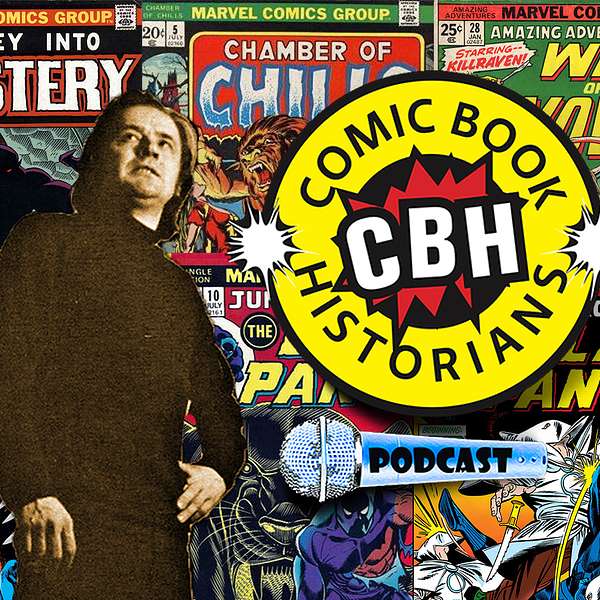
Comic Book Historians
As featured on LEGO.com, Marvel.com, Slugfest, NPR, Wall Street Journal and the Today Show, host & series producer Alex Grand, author of the best seller, Understanding Superhero Comic Books (with various co-hosts Bill Field, David Armstrong, N. Scott Robinson, Ph.D., Jim Thompson) and guests engage in a Journalistic Comic Book Historical discussion between professionals, historians and scholars in determining what happened and when in comics, from strips and pulps to the platinum age comic book, through golden, silver, bronze and then toward modern
Support us at https://www.patreon.com/comicbookhistorians.
Read Alex Grand's Understanding Superhero Comic Books published by McFarland & Company here at: https://a.co/d/2PlsODN
Series directed, produced & edited by Alex Grand
All episodes ©Comic Book Historians LLC.
Comic Book Historians
Don McGregor Career Interview part 2 with Alex Grand & Jim Thompson
Alex Grand and co-host Jim Thompson interview comic writer Don McGregor, in a second parter on his road to Black Panther, discussing how he moved from Warren Magazines to Marvel in the early 1970s, his first writing job with Gardner Fox, Amazing Adventures with Killraven with P. Craig Russell, his Black Panther run with Rich Buckler, Gil Kane, Billy Graham and his sincere fondness for Gene Colan. Edited & Produced by Alex Grand. Images used in artwork ©Their Respective Copyright holders, CBH Podcast ©Comic Book Historians. Thumbnail Artwork ©Comic Book Historians.
Alex: Now, when you were at Warren, did you leave Warren to then do the proofreading job with Marvel in 1972? Did you work at both? Because you first work at Marvel was Journey Into Mystery #4 which was cowritten with Gardener Fox. How did that all come about?
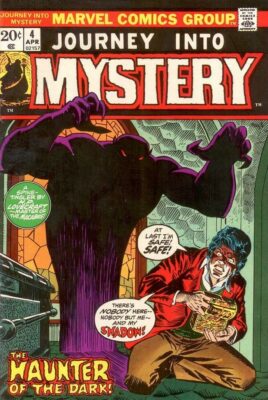
McGregor: Because they called me in Rhode Island. Time, like I have told you earlier… I was traveling into New York. Whenever I had enough money, I would just get a roundtrip ticket, take the bus in New York, stay with Billy and Alex for as long as I can. When I totally ran out of money, I’d used the bus ticket and come back home. I had worked for the National Guard for a while, and I stayed with that.
To be honest, like most people probably would have stayed with that because it was a government job, but my temperament wasn’t such that I should probably stay there. I’d probably ended up in the grave. I wrote a story called This is the Valiant One, Signing Out that Billy Graham drew for Monsters Unleashed at Marvel later on. That’s all the stuff about the soldier being called before a promotion board and being accused of being prejudiced against military policeman. It’s all based on facts.
At the timeframe that I was there, this was during the spell when there’s a lot of riots going on throughout the country… Not going to go into various stories on that, but because we had people in that unit that were racist and had said stuff like killing blacks. It was in very terrible times. And I reported them to the captain of the unit or whatever it was. And then when they put me in front of the promotion board they decided, I guess, that I was prejudice to the military policeman. I could see the lay of the land. And I was in a cellar that was in an armory. It had bars on the windows, that are ankle high, the view outside was on the hill. There’s people’s feet walking by it… I was going to get out of there…
So, at any rate, I was working a number of different jobs. I’ve heard somebody from editorial, recently, they keep changing the story about my getting there… That they’d saved me for life as a security guard. That that’s just all I ever would have been if they hadn’t offered me a job at Marvel Comics.
Well that’s bullshit. I had a house with three bedrooms, and a fireplace and a garage, and had a view of a pond across the lake, and three blocks away was a private stretch of beach, an ocean front. And I gave it up for $125 a week job at Marvel Comics.
McGregor: So, I want to know how many people would do that. And I had a daughter, that was at the time… I would imagine Laura was about two, I guess. Something like that. But it was a chance to write… I love Marvel Comics and I was already writing for Warren, and I was very close to selling stuff to Mike Shayne Mystery Magazine and Cosmopolitan. That’s where I really was aiming toward. That’s why I had the collection of short stories were able to come about. Those are stories, originally, that I had written when I was peddling my stories.
I never went to Marvel Comics, and I never went to DC. Doing the comics at Warren was just fine for me. I had a good relationship with Jim Warren. I had good relationship with Billy Graham. Like really, except for the money, there was no problem there.
When I went to Marvel to do the editorial job, in the beginning, I mean I really was kind of like there as kind of as an editorial gopher… But a majority of the job was reading the reprint books that went out. And so that’s how the Gardner Fox story comes about. Some of the reprint stories were like horror stories they did in the ‘50s, and while I don’t, to be honest with you, recall what the problem was. It was something that the Code wasn’t going to approve that was in that story. I don’t have any memory of what it would be. So, they wanted me to rewrite it, to write a new ending or something, that was suitable for the Code.
I have no memory of what that was. It has me listed as writing with Gardener Fox, never met Gardener in my life… Okay, if you want to put it… That’s probably what I did, I guess, but it was really just writing some new ending or I think maybe we had to change a few panels here and there. I really don’t remember what the deal was.
That was the job I was doing there. I was reading the reprint books. And part of those reprint books was Jungle Action. And so, one of my reactions was, to the Jungle stories, and saying something to editorial like, “I can’t believe you guys are putting out this racist stuff.” This, in the 1970s. “I just can’t believe you’d reprint this stuff.” I wasn’t even thinking of the Black Panther, I know I had said something like, “Can you at least have a black character that’s a Jungle arrow?”
[00:05:04]
I wasn’t thinking that they rewrite new stuff in there or that… I had no power in those days at all at Marvel Comics. I was just there proofreading the reprint stories.
But there’s a lot of unwritten rules in the comic industry at that time. And one of it was like, if you had an editorial job, and you’re on staff, that somewhere along the way you would be given a chance to write something… When I was given the Black Panther and Killraven, I was given those books, I found out later… No reason for this person to lie to me about it. And it was Steve Gerber who told me that he was on a meeting when they decide, “We’ll give Don this Jungle Action Black Panther thing because jungle strips don’t sell.”
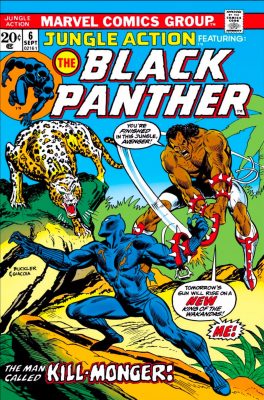
At that time, I think Joe Kubert have been doing Tarzan for DC, and I guess it hadn’t done very well. And I think the general attitude in people with the suits was that, like I guess, they’ll toss in the comics… What the hell in that genre can you sell? They felt these books are going to die, and they could tell me that I had my chance. And I think they knew I had no political aspirations. I wasn’t trying to become editor-in-chief. I had no interest in it whatsoever, and/or if I did, I was going about it in the strangest way possible. I was only involved in doing whatever work, as it came in, and when I had the chance, writing my stories.
I think at that time I probably was still doing some stories for Warren but… I know Jim was upset with me because I went over to Marvel. “Don, you were training with me, now you’ve traded down.” And I said, “Jim, you’re paying me…” I think by that time, I was getting $40 a story. “You’re paying me $40 a story. Give me a break, Jim.” But Jim and I stayed friends. I’m still friends with him to this day.
Alex: Syd Shores did some art for your story in Chamber of Chills #5, 1973. Did you meet Syd?
McGregor: No.
Alex: No. Okay… So, a lot of times, you’d put in a script, and it’s not like you’d meet the people that did your stuff, right?
McGregor: Well, that’s actually not the case for me, but in that story, yes. I don’t remember exactly how I got the offer to do a story… That would be one of the places that if you were starting out to them… Because the Warren’s stuff didn’t count. It didn’t matter what, people will say, The Fade-Away Walk, and/or The Men Who Called Him Monster, A Tangible Hatred, a lot of those stories, a number of people were involved… Especially, The Night the Snow Spilled Blood. I think Jim Salicrup, I always teased Jim, to this day. I say, “Jim, I never got better than that, right? I peaked.” [chuckle]
But those stories didn’t mean anything for Marvel editorial at all… But when you got offered things, because… There’s only one story I could think of that I wish I had never done, and they wanted me to adapt an August Derleth story in the comics, Vampire Tales or something. And it’s not because I think I’m a better writer, or a storyteller than Derleth. I didn’t agree with the story, I didn’t like what it was about, and I tried to turn it into the best comics I could. But I think it involved a little kid somehow. And it was like, it’s not the kind of story I would do.
I would’ve said no, but I also knew that if I said no, that’s just not the way things were done. And like, so the first time you’re offered a story you say, “No, I don’t want to do it.” I couldn’t find any way that I could just say no, and not have it have real consequences.
Somewhere in that same time frame, I was told, I was told I could do a six-page story in that horror anthology book or whatever it was. And editorial didn’t like it and even said they shouldn’t have let me get away with it because it wasn’t good comics or something. I don’t know. You know, people can judge for themselves because the story is the story. It’s still the same story that I wrote. I had no problem with that story. I mean, yeah, it’s like with a lot of it, I wish a lot of it were better. But for a six-page story… Give me a break. [chuckle]
McGregor: No better or worse than anything else that was in there. There’s a couple of lines… I think I liked the last lines and the ending. It’s very kind of in a Rod Serling kind of vein.
Alex: There you go.
McGregor: If you’re being so cryptic on this, probably it’s a poor Rod Serling, but still evolves, you know, a good influence or whatever. So that’s how that story came to be.
Alex: So then now in 1972, was basically Roy, the editor-in-chief at the time you joined or was Stan still editor-in-chief at that time? Did you talk much with Stan Lee around this time?
McGregor: Stan was not in editorial all that much. He had his own office, off to the side, but Stan was very much going around doing promotion for Marvel and doing speaking engagements and things like that. He was there. I didn’t see all that much of Stan, but I certainly had some dealings with Stan. Especially when it came to doing the interracial kiss at Marvel Comics because that ended up being a much bigger situation than I had realized it would be, when I started to do it… Oh, does that answer that question, Alex?
[00:10:09]
Alex: Well, it kind of does. Yeah… And Jim is actually going to take that baton and talk about, a little more officially, your time at Marvel. So, go ahead Jim.
Jim: Before I get into Jungle Action and Killraven, I want to talk a little bit about the people you were working with in 1972, or at least the people that were fellow writers and artists at that time. Because this is my favorite Marvel period. Really. The Steve Gerber, (Steve) Englehart’s Doctor Strange… Starlin. What was it like? Did you guys realize just how cool your comics were at that time? Was there a competition between you to churn out the best stuff?
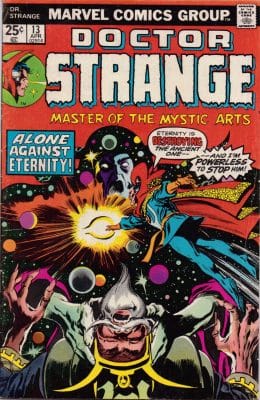
McGregor: No, I think most of the stuff you’re talking about, the people were doing it independently from wherever they were situated. I don’t really remember even meeting Jim Starlin, I might have come crossing… Because I was on staff in the beginning. You might’ve run across more people because that’s where you work. You weren’t at home writing or putting the stuff together. There were people I was close with, especially… As when I was really close with Rich Buckler, and Craig Russell, and Billy Graham, and they’re all artists.
You have to understand the books themselves, when they came out, were not really thought of fondly by the Marvel editorial. Other than the Black Panther or Killraven, I can think of three people, off the top of my head, that liked those books. And that would be Jim Salicrup, and David Anthony Craft, and John David Warner. There may have been others, I’m not saying there wasn’t, I don’t know. But those are the three I can really think of, in terms of writers that I actually hung out with to an extent. But that would have been like more later.
Because a lot of stuff happens in between ‘73 and ’75, not just with the books, with my personal life, everything comes apart then. The scenes, it’s a turbulent time and it’s full of really big highs, a lot of excitement and really becoming aware of the readers and the fans, and having a real intimate connection with them, and at the same time fighting to do the stories that I wanted to do and becoming really good friends with the others I was working on.
McGregor: Yeah, I didn’t get to see the others who work on those short stories, but when I was first up in the officers, I don’t remember how we first met. But Rich Buckler had an office space up there. Rich had a lot of power those days at Marvel. He was doing a lot of covers for them. He was doing important A-list series like, The Fantastic Four, The Avengers, or whatever books Rich was doing.
He was doing a lot of covers, so he was very much in demand, it gave him a lot of leeway into what he wanted to do at that time. Somehow while Rich was there, we met and got to be friends. And I think it was because we both want to do comics. I really had to stick, that is what I wanted to do, storytelling wise. And thank God Rich, embraced that, and anything I virtually asked of Rich he did…
There’s so much work, because remember, no matter if you spend one hour on a page, you spend a day on a page, you spend a week on a page, you get the same amount of money. So, like many people are trying to turn this around as much as they can because they’re trying to make a living, and at the same time they’re trying to do the best work they could do.
So, it’s a dichotomy there, and I get very fortunate because when I was given the Black Panther to do, Rich said he was going to do it. They didn’t want Rich on books, they want him on important stuff. But because Rich wanted to be there… And Rich got me to move out to the Bronx.
Before that point in time, I have been staying with Alex Simmons. By that time, Alex was now out of Spanish Harlem, and he was living in Brooklyn. So, in the beginning, I was kind of staying with him while looking for a place, and it was Rich Buckler that found me a place up in the Bronx because Rich wanted us to be together.
I’m working on staff during the day, and then I would go back up to the Bronx at night, eat dinner, and then I would go over and stay at Rich’s for an hour or two, and I would actually get to pose and say, “No, the Black Panther is going to be like this.” You can see photographs of me, that still exist, of me doing Panther poses for Rich, and designing a lot of the title pages. That takes nothing away from Rich. Rich had to pull them off. I remember, I would say, “Hey Rich, can we turn the page on the side so we could do that waterfall?” And it was where I felt I could get the most extreme height for the waterfall.
I mean, you have to continually remember that we only had 13 pages of the story that had to last the readers for two months. That’s not a lot of pages that get the audience to invest in your characters, in your story, in what this is about, to come back the next time around.
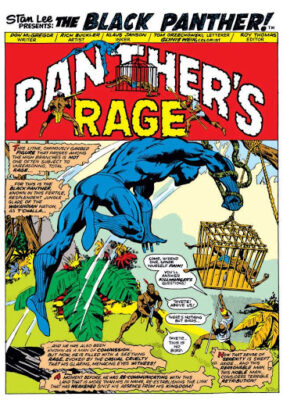
[00:15:05]
I was well aware, for instance, if I wrote W’Kabi, or Taku, or in Killraven, M’Shulla and Old Skull, whoever it should be, if I wrote them off of one issue, that meant the reader did not see them for four months. If I left them out for two issues, that’s half a year. That’s really a long time to ask an audience to invest in a character. So, I was very determined. That was one of the things, I was always trying to address that the characters in each issue, that they had a presence and there was something new about them that you would learn if you were an old reader. And if you were a new reader, you would be introduced to those characters so you would know who they were. But there were a lot of things to consider before you could start those scripts.
Jim: So, when you and Buckler were working on the very first one, Jungle Action #6, was there a notion that you all were going to break a lot of rules, and really do just something extraordinary? Because it’s not just the writing, which is sort of unprecedented in terms of how style and things, but the story itself with its Steranko style title pages and certain other aspects of it. It really did stand out on the market, it’s different from your average Marvel book. It was like nothing I had seen. Was that really trying to achieve something completely different?
McGregor: Well, I hope as a creator, you just… That’s part of being uniquely who you are, for better or worse. I had no interest in what other people were doing. That’s their business, not mine. I can love it, or hate it, or be in between about it, but I’m coming at that as a fan. To be honest with you, by the time I was writing the books, I’m invested in writing the books.
When they gave me the Black Panther, I was told basically one thing, “You’re going to be doing the Black Panther, and it set in Wakanda.” So, at that time, there had been very few Black Panther set in Wakanda stories. If there were over half a dozen, I’d be hard pressed to like say how many over half a dozen.
Jim: Yeah. there was that Avengers issue with Buscema, and I can’t think of a whole lot… And the Fantastic Four, obviously. But there wasn’t very much at all was there?
McGregor: No. but there were a lot of Black Panthers. I read everything. And in those days, you could. And the fact, Jim Salicrup lent me his books because, at that time, much of my stuff was still back in Rhode Island, so, I didn’t have access to it yet. Because in the beginning, when I first started writing it I probably was still living with Alex. But when I actually first started. I’m not sure of that. but like right after that, would have been moving up to the Bronx. Because I know when Rich and I do Morbius, the Living Vampire together I’m definitely up at the Bronx because when I do the conclusion of that first story, the cops came to my apartment at midnight. So, that part of it is emblazoned in my mind, and I definitely have to be in the Bronx by that point in time.
So, within a very short time of being given the books, now as I was reading the books, I’m like, “Okay, what do I like, and what don’t I like? And what do we have?” Because there was so few stories, and because you’ve got this great concept between Stan and Jack, on the Black Panther, Wakanda and this hidden super-secret African society, but essentially the place, at that point in time, is basically the palace… I don’t know, maybe there’s some woodland area, and the Vibranium mound… because you don’t have like…
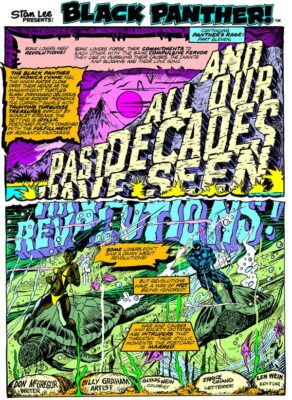
McGregor: Say, the first two Fantastic Four books, well, you got the Fantastic Four like Wingfoot is in there at the same time and then you get T’Challa. So, you get six characters right there, that you’re going to be dealing with, and you’ve only got two issues. I guess… I don’t really remember the stories off hand, but it meant that… From the beginning, I thought, “Okay, so T’Challa is going to come back to Wakanda.” Because they had him in New York, teaching in school in Harlem.
Now, why the king of an African nation would be a school teacher in New York, is beyond me. I understand why they did it. They wanted to get T’Challa into the United States so that they could have him be a part of the adventures with the other superheroes, and eventually he becomes part of the Avengers… I don’t know that he has much to do there… Anyhow, I don’t have much memory of it, but…
Now, I’ve got to find a reason when he comes back… One of my first thoughts I remember having was, “Okay, we’re doing a bimonthly book of 13 pages. And it’s a superhero, so there’s going to be a super villain in there somewhere. And if I do them as separate stories, that means every issue there has to be a new villain introduced, and then there has to be something that they’re doing.
Eventually, I thought, well, after three or four issues, the Wakanda should just go to T’Challa, “Why don’t you go back to America? Because before you showed up, we’d never had any problems.” So that was my first inclination… Okay, this has got to be one story. It’s all going to be linked together.
[00:20:02]
So, that the adversaries that he’s coming up against… Oh, it’s, there’s a reason for that… And then that led to the creation of Killmonger. Somebody who, if a king abdicated his kingdom, who’s… What’s going to happen? There’s a revolution and… War was going on at the time so, that was something… I guess, I thought there was a lot of stuff I’d be able to write about there, and it would anchor the character. So, that began to develop the idea of doing the story as a novel.
Jim: It’s interesting because it occurs to me that Kirby was doing this with his New Gods book as well, where there’s a central villain, but each month you would be introduced to the various lieutenants, and they carried the story forward. But the real tension was waiting for the return of, or the appearances of the master villain in it. And I can’t think of very many examples of that on a long period of time except for yours and Kirby’s New Gods.
McGregor: I’ll take your word for that. I mean…
[chuckle]
I think the New Gods was done later than the Black Panther. We’re talking ‘73 for the Panther. I think isn’t this New Gods stuff at DC a bit down the line or…?
Jim: No, no, it’s the same period of time.
McGregor: Okay. Quite possible. I don’t know. It’s so far field… It wasn’t a part of my reality. My reality was the Black Panther, and trying to figure out, “Okay, what is this going to be?” And it just seemed to me, it had to be tied together. And then originally it was to be like 10 books, I think. I knew thematically, there was going to be a major theme that ran through the entire course of the storyline and then each issue would have its own minor theme, but they would also amplify the major theme of the story.
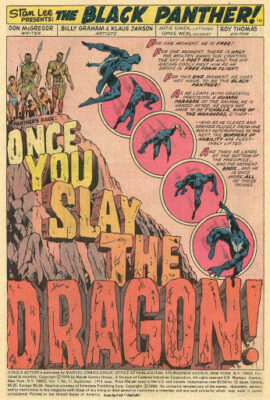
McGregor: I’m not sure why 10, because even though it was an extended story. I think as I mentioned earlier, I really loved the old Republic serials. I’m not sure why I didn’t do it in my head as 12 or 13. It seemed, I guess, it’s just I had 10 stories. I haven’t got it all flushed out, just the idea, “Okay, it’s going to be 10.” It did eventually become 13 with the epilogue because the center stories needed a lot more room than I had initially given them for the themes that I wanted to deal with.
So, at the same time that it was coming up with that, because I worry about everything, I thought, “Okay, that’s all the Panther stories, maybe there should be novels, if I stay with it…” So, before I even wrote a page of Panther’s Rage, I realized when I was reading the books that no one has ever mentioned the Black Panther’s mother. And if you notice in Panther’s Rage, I never mentioned his mother at all. So, I thought, okay, the next storyline will be, he goes to South Africa, and has to deal with apartheid while he’s searching to find his mother, who for some reason, and I don’t know what the reason was, wasn’t in South Africa.
Unfortunately, by the time I was finishing Panther’s Rage, I was in the midst of a very emotional divorce. I was going to custody courts to keep seeing my daughter. I was fighting with editorial all the time. It was a very tumultuous time, and I realized I’m not going to have the focus and energy that I would need to research doing a story set in South Africa. And that’s how the Panther Versus the Klan becomes about. Because I could take him Monica’s home state in Georgia.
I had noticed that already there was an extremism that was starting to appear in America. The Klan was on an insurgence in various states in the union. The Reverend Sun Myung Moon are loud with the very strict religious groups who felt their way was the only way and there was no other way. It seemed to me, well that’s something worth writing about. And I don’t need to do a tremendous amount of research to bring him over to America. And so that’s what kind of made me lean in that direction. And also, something I wanted to write about and it would be a totally different kind of story.
I wasn’t interested in writing the same story over, and over and over again. In going back to the beginning, so now I also decided in doing Panther’s Rage, T’Challa needed a villain and that again… Now, we’re working on an idea that the stories are going to be connected, started working on the creation of Killmonger. As much acceptance that character has these days because of the movie, you have to understand that he was not accepted by Marvel editorial at all. While he appears on the first cover, after that he was not allowed to be on the covers anymore.
And your just your question is, “Why is that Don?”, well, the reason is, because they were not used to a black character that was as angry, and as ferocious, and as strong as that Killmonger was. So literally, he couldn’t appear on the covers again, and if you think I’m just saying that, you just have to look at the covers. He doesn’t appear again until after years with the books, and when he does, he wasn’t even scheduled to be on that cover.
[00:25:14]
McGregor: I need to back up for one minute on this, because I had no power over the covers. What you see in those covers, I had absolutely nothing to do with it. Love some of those covers, the only way that I had anything to do with them is they’re inspired by my stories. Because those books were low priority, they weren’t A-list books, editorial would go over them with whoever’s going to do the covers, whether it was Gil Kane, whether it was Rich, or whoever might be doing the covers, they would go over with the artist and discuss what the cover was going to be. I had no input into it whatsoever.
The cover with T’Challa is being attacked by the ice wolves. Originally when Rich, drew that cover, only the wolves are on that cover. And if you look at the cover, you can see there’s a little figure of Killmonger. Editorial had decided, “No, no, it’s got to have a human villain in there”. And they didn’t have the cover redrawn. They had Rich put Killmonger between the wolves’ legs. It was like a tiny little action figure and it looked like, “Look, he’s back, Killmonger.” And that’s the only time he appears on the cover of a book from the first time that he was introduced into the series. And then he’s allowed on the last book of Panther’s Rage, which is two years and some months later he’s allowed back on the cover.
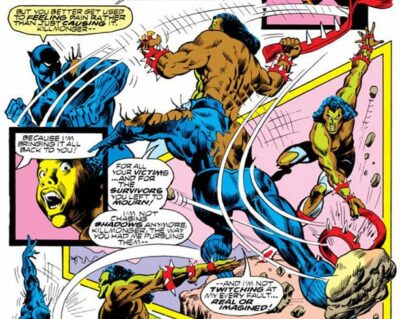
Alex: Who at editorial would you say…
McGregor: I’m not getting into the he said, she said thing because you know what? We do that and then suddenly it becomes, “Oh, it’s because Don doesn’t like that person, or he doesn’t like… or that person doesn’t like that person.” And the problem is, you’re not looking at what the situation, what you could do at pop culture and what you couldn’t, and there were unwritten rules.
The problem that came with the Black Panther is, I’m given an edict, “You’re going to do the Black Panther set in Wakanda.” that’s it. Everything else is whatever I came up with, and then discuss with Rich, and we had to pull off… And unlike the movie, by the way, we don’t have millions of dollars. We can’t go to a set designer. We can’t go to costume people. It all has to come in from when you’re first creating the stuff. So, now you’re trying to create the villains, create the themes, create stories and it all has to be put together within the bi-monthly schedule. [inaudible]
Jim: I remember that cover that you’re talking about because it had a purple background and Klaus Janson inked it. It was striking though. You were lucky because you had two of the principal Marvel cover artists working on the book at various times. Because you had Rich Buckler and then it was followed by Gil Kane. So, you had tremendous story sense as your collaborators. Not to mention once it becomes Billy Graham.
McGregor: Because Rich fought to be there. Whatever storytelling ideas I had, Rich had no problem, because we’d be sitting side by side while we were working on those initial books. It’s amazing that Rich had half a year on the Black Panther. He did three books and by that time he, it was just the way he could continually fight off. I don’t know how Gil Kane got to be on the one issue in between. Gil wanted that extra work that month, I don’t know. Maybe he liked that genre, I really don’t know because I didn’t know Gil that well. I certainly had met Gil and talked with him maybe briefly, but I didn’t really know him. Not like I did Billy Graham and Rich Buckler.
McGregor: So many people think that I got Billy on the book. I didn’t have anything to do with getting Billy on the book. Yes, Billy and I were good friends… And by the way, you mentioned When Wakes the Dreamer, which was the first story I sold to Warren. The reason it didn’t see print until years later was that Billy liked a number of the scripts I had done for Warren, and he took them, along with The Vampiress Stalks the Castle This Night, When Wakes the Dreamer and a couple of others, and he had taken them because he was going to draw on them. And yes, he drew the first page of When Wakes the Dreamer, which was often my page layout. And I still have that original line. It was beautiful.
But Billy was the art director at Warren at the time, and I think he just didn’t have time to spend doing the artwork that he wanted to do. And I think that’s eventually the reason why Billy quit. He didn’t want the staff job. He wanted to be an artist. Billy wanted that freedom. Not to just be like… would give him freedom so that he could do a lot of things. Billy had a lot of talent. Billy was truly a Renaissance guy.
Advertisement
But you know, Billy also wrote, he also acted, he also did stage designs. He did stuff for the Amsterdam News. He was really a busy guy. And when we do the Sabre, Exploitation of Everything Dear, a storyline that Billy drew, which hopefully will come out sometime this year, with all the artwork restored and seen in a way that you’ve never seen it before.
I’ll tell a lot of the stories about my times with Billy, but I’m not going to say them here. One thing though that I realized… Oh, a lot of the adventures that we had… At the time that I was with Billy, he was living the life he wanted to live in Manhattan and that was his city.
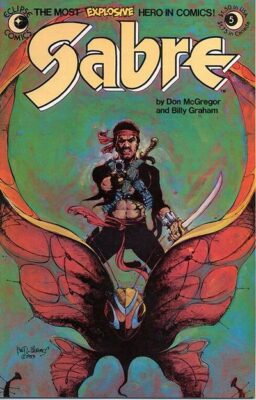
[00:30:04]
But now, I know he’s got a granddaughter, I’m thinking… It’s kind of like the old Bob Seger song Against the Wind. He has the line, “What to leave in, what to leave out”, and now that I know he’s got a granddaughter, I’m like, “Oh, I don’t know, some of these stories, maybe… I’m not sure.” At one time I’ll tell a lot of Billy’s stories that I just have always kept so that they’ll be preserved in the book that showcases his artwork.
But anyway, I didn’t choose Billy for the Panther’s Rage book. I didn’t have that power to do that, Marvel editorial put him on. And the deal was, in those days… And I don’t care who wants to admit it and who doesn’t want to admit it… Most of these people do not want to admit where they were at in 1973, and 1974, and 1975. But if you are black and you are an artist in comics… And by the way, I don’t know if there were any black writers yet at Marvel Comics, but if you are a black artist, you would normally be put on a black title.
McGregor: So, Billy, say for instance, was on Luke Cage, Power Man for the longest time. And that’s the reason that Billy ends up on Black Panther. Later on, obviously, that would change. But at that point, editorial was not crazy about the fact that everybody in the series was black. Now he asked me about what, was I trying to be ahead of my time? Was I trying to do stuff like that to show, “Oh, look we’re…” I don’t remember the phrases that were used…
Here’s the whole reason why there’s a black cast of characters in Panther’s Rage. I am told that the stories are set in Wakanda and T’Challa returning to Wakanda. What is Wakanda? It’s a hidden African nation that nobody knows it’s there. It’s so sophisticated, T’Challa has found a way to keep everybody from knowing where it is. Doesn’t matter what country it is, they can’t get in there. You can’t have stories where there’s white people just keep stumbling into Wakanda, and finding Vibranium, and trying to steal it. There’s got to be other storylines.
But that also means that every character is a Wakandan. So, that means… Where are the white people supposed to come from? And so, as the stories went along, it became more and more of a problem. Where is the white people? They bring the Avengers in.
But as I was doing the conventions, and I was meeting people, and the people were writing for the book, a lot of what was given the applause by the media for the movie, is stuff that was in the books back in 1973 to ’75. But the only reason it was done is because it’s set in Wakanda, and that means that all the characters have to be Wakandan. Therefore, you virtually had an all-black cast except for Venomm.
Jim: And I want to talk about Venomm because I think he’s an important character as well in terms of breaking ground, and we’ll talk about that in a minute. A few art questions on this, that one issue that Gil Kane did is interesting to me because I think a lot of fans of the series remember that issue especially, and it even shows up in the movie because Gil Kane was a great jungle animal artist. He worked on Tarzan strip and he really knew how to draw animals. That sequence with him and the rhino is just brilliant, and I remember that very vividly. Did you try to write at all to the strengths of the three artists that worked on the strip, or did you just keep it the same throughout?
McGregor: Okay. I’m sure I didn’t know that Gil Kane was going to draw the issue that he drew.
Jim: Okay.
McGregor: I don’t know how it got to be there. I think the issue looks terrific. I have one memory or two memories of that particular book. Obviously, it was a much different situation than working with Rich, because I was with Rich all the time. So, we were always going over the pages, and Rich and I were also doing Morbius the Living Vampire, and we did the Hodiah Twist story, the Vampire Tales as well. So, Rich and I were together a lot doing different stories and we work very, very closely together.

McGregor: I really had no contact with Gil. The two things I remember about that issue is the title page because Gil didn’t do the title, But Now the Spears are Broken. Danny Crespi actually did, who was the head of production at Marvel at the time and Danny was really kind to me.
I remember Danny saying, “Don’t worry, I’ll do this page the way you want it done.” And he got the book and I want the broken spears in there and the lettering for the title, and he hit it like… He had a bundle of corrections of things that he was supposed to do. And they definitely would not have given that to Danny. That was Danny being kind. And I think, both John Verpoorten and then Danny Crespi thought, “this business is going to eat this kid up.” And I think in their own ways, at times, they tried to be a little bit of a buffer trying to protect me from powers that may not be so benign. So, Danny did a lot of the work on that. And the only other thing I remember is that the sequence where I had all the murder clues.
[00:35:02]
Originally, the mise en scene was all in the big palace sequence, and there were no closeup panels of it. And that was Gil went that way. At first, I wasn’t sure, we were pretty much too much in the face of the readers? But when it finally got done, and when I finally saw it, it’s like were we even playing fair with the readers because now, it’s right there and they can’t say it was just locked in and hidden in the background. So ultimately, I was kind of glad that he went that route. But that was to show you how much I was thinking about how a story should be told, for any particular scene.
Now, the difference with Billy is I could design a page any way I wanted and Billy said, “You design whatever you want done, I will get it drawn.” And Billy was terrific. I mean that part of it, again, I got really lucky. I was with somebody who’s really talented and who believed in what I was doing. Because really, as a writer, you could bleed onto the paper. You can care all you want, but if you don’t have an artist to bring you to life, I’ll tell you, you’re just dead in the water. So, I got very fortunate that I had Rich and Billy for the Black Panther, and then ultra fortunate that Craig Russell, but that’s a whole other story.
Jim: So, let’s talk about the actual characters you created for Panther’s Rage. Because they are indelible. Venomm, I want to talk about, because he was the one white character, and probably I won’t say the least intelligent but the least eloquent in his phrasing, and in his talking. What were you trying to do with him? You ultimately made him into an incredibly sympathetic character. Did you know you were going to do that from the very beginning?
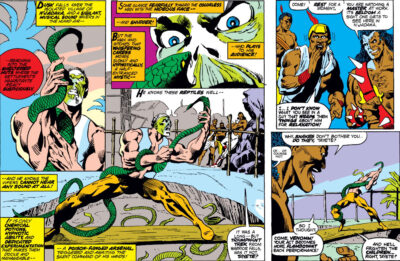
McGregor: I think you can assess that, reading the stories, to be honest with you. I always hope that when people are finished with say, Panther’s Rage, that if they went and back read the books from the beginning, they could see, “Oh, Don was setting this up as early book one, or book four.” Take Kantu for instance, he’s like from that first page with rhino charging, he becomes a major character and he keeps appearing throughout.
McGregor: Obviously, the ending he’s there… I didn’t tell anyone, if I had, I’d never would have gotten it through. As time went by, one more I learned to keep my own consult. And by the way, I never talked to other writers about what gig I’m going to do in comics, certainly, at that time. Because they’d want to tell you how to do it; how they would do it, “Oh, no, I have an idea.”
You’ll never be able… Or people can say it, but there’d be absolutely a lot. That’s why I never discussed what I was going to do. Not even with, I’m sure that Rich never would have known, Billy never would have known how Panther’s Rage was going to end. They knew what I was doing when they got the script. There might be somewhere down the line, that I might say, “Oi, Billy, you make sure, you need to do this because I’m going to pick up on that later.” Well, what I was going to do with it probably I’d never told, even though certainly it would have been safe to tell Rich and Billy. They would never have gone to anywhere where you could be told that you couldn’t do it.
Because editorial’s, most often, they’re going to tell you, “No, you can’t do it.” And if you’re told, no, you can’t do it. And then you try to go ahead and anyhow, and do it, then that’s open defiance. Then it’s going to be war. And ultimately, you’re not going to get anywhere as a writer, it’s not going to help you get to where you need to go. You need to find a way to stay as much away from them as possible, and concentrate and focus on what the story you’re trying to tell because he was also the first gay character I have ever made.
Jim: Well that’s exactly where I was going. I was gonna ask you, did people ask you about that? Readers, or editorial, or did you just spring that on people?
McGregor: Obviously, I was very careful of that. If you notice, because the thing was… Don’t forget, I was doing Killraven at the same time. So, I was kind of alternating. On one month, I guess Killraven came out, the next month the Black Panther, and back and forth. So, when I was doing Killraven… Again, I got a lot of things to consider. What am I going to do with this? Again, that was a book, I think, they had high aspirations for it in the beginning when they started Killraven. They had a lot of named art on it, but the title went through three different artists and writers, I think, in the first three issues. Well that’s kind of a death knell for a book, anyhow.
Science fiction wasn’t noted to sell. I think if the initial thing had been able to be done the way with the talent they had initially started it with, it would have been totally different. But now you had three separate writers and I was starting with the fourth issue. And I’m sure I’ve made an enemy here, but I think the writer doing it said, “I’m going to tell you everything you have to do.”
I said, “I really don’t care what you’re going to do. I just want to write my own stories. You guys are writing like four or five books a month, can’t you possibly just let me write my own stories?” But they didn’t think I was a good enough storyteller to do that. And so, when the fans started reacting so much to the book, there was a lot of antagonism about it.
[00:40:08]
There’s a lot of egos at play there but also there was also things what you could or what you couldn’t do.
McGregor: And I knew early on, for instance, that I was going to have the M’Shulla and Camilla get together. Pretty quick and to bring her into the group, I knew this was something I’m going to do. I might not know exactly what I’m going to do with it, or how I’m going to evolve that. And I did the same thing I did with Taku and with Venomm, every issue they had a scene, they had a scene that was just theirs.
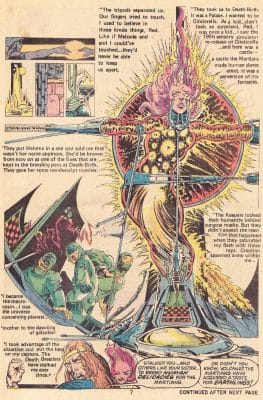
Jim: That jail scene is my favorite scene in the entire series.
McGregor: Oh great. [chuckle] All the characters had a scene that was theirs. And if you’re looking at the approach to leading up to Camilla and M’Shulla being together, it’s kind of the same format, if that’s the word I want to use. But continually you see, that’s the two of them together and it’s very intimate. There’s a real connection between the characters, but they’re not the same characters. They have really totally strikingly different personalities.
But while doing the Killraven thing early on, and I had just done a couple of sequences, with them together, it was then I got called into the editorial office. They want to know if an artist has objected to “the salt and pepper relationship”. That’s their quotes, not mine. And so, then I was being asked if I was going to do a salt and pepper relationship in the Killraven strip. And I knew it was too early. If I told them I was, I was going to be told I couldn’t do it.
A lot of times. when you’re speaking with people in comics, you have to figure out a way of expressing it that they’ll get and that they’ll understand. And at that time, Modesty Blaise was a big favorite of many people working in comics. So, I said, “I basically, right now, it’s just mostly Blaise and Willie Garvin, your friends and warriors together. That’s something like that.”
Then I kept hoping that you guys would come along and keep saying, “God, when are you going to get these two together?” But I had an artist quit the book, so now I know I have to be really careful with the Venomm and Taku stuff. And I knew I could never have him come out. Then I was already on shaky ground with interracial stuff.
Thankfully, the readers really did start as well. When I felt that I had enough support from the readers I could say, “Okay, I want to go see Stan on this.” I could’ve just gone to Stan. Stan had an office there. But it’s all protocol. This is just like being in the military. If you go and you sidestep the sergeants and lieutenants, and you go to the captain, you’re basically declaring war. And that would mean everything I want to do in those books would become more difficult to do.
So, then you had to do it according to the politics of the place. So then, I went into editorial, saying, “I want a meeting with Stan to discuss to him an interracial kiss.” Because now if they turned me down on meeting with Stan, then they have to explain why it is. Then if it gets to Stan and is questioned about it… “Why wouldn’t you pass it?” Going that way, Stan was the one who could actually make that kind of decision and say, “Yes, it could be done.”
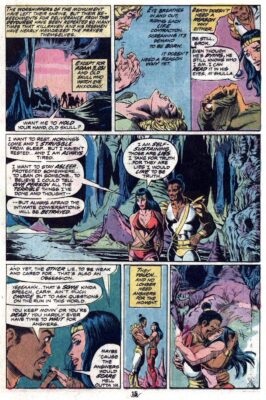
It seems like odd that this was even us discussing this, in 2020, but in 1973, ‘74 whichever year that was, it wasn’t. And so eventually, there’s the big meeting with Stan, me and editorial… But I knew how to approach Stan on this kind of thing. If I had a shot at all of doing it. Because it’s not enough to just write it. If you can’t get it to see print, if it can’t become a reality that you can hold in your hands, what’s the sense of even doing it? You’ve got to have a shot, knowing that you’ve got a chance to make it reach the audience.
McGregor: So, we met with Stan, at some point. I know Stan said, “Don, can’t she be green?” And I said, “Well, you know Stan, what are you going to do? Well she isn’t, she’s white… “ He goes, “I’m just concerned that PTA in some place downtown is going to see this.” Editorial said, “Do you want your kids seeing this in the comic book?” And I said, “Well, you know, the thing is, Stan, I don’t know, I’ve heard rumors that DC has been talking about doing an interracial kiss on one of their romance comics.”
Jim: [chuckle]
McGregor: “And I think it would just be a shame if DC would have to do it before Marvel.” And so, Stan was, “Oh, I don’t want that, Don.”
Jim: So, did you just make that up?
McGregor: No, I didn’t just make that up. I knew that that was going to be a real persuasive factor. If you approached it that way, you had a real shot. And then Stan says, “Okay, I’ll tell you what, Don…”. Then editorial said, “You could do it, but you have to handle the panel, and knock out colors.” And knock out colors means that both characters would be colored purple. Apparently, their idea was so that nobody could take the panel…and hold it like, “Look, there’s an interracial kiss going on here.”
By this time, I’m being called into the editorial office on every single book I… They don’t care which book it is.
[00:45:01]
The book comes out and then this like, you know, I’m called into the editorial office and we have to have some discussion. So, when that book came out… So, a lot of times the books didn’t really get read until they were in make, ready for view, the lower tier books.
And the line was expanding at the time. The only reason these books kind of got to exist is there wasn’t time to go over every single book. And the books that were really being gone over where Spiderman, and the Fantastic Four, the big titles, Thor, or whatever were considered the big titles. These 13-page that became full books later on, they definitely didn’t get the same amount of attention. And now Marvel was expanding into its black and white line, everybody’s always over extended. And so that’s how those stories managed to get through.
But when that book did come out, I remember being called at the editorial, “Look at this! Look at this panel.” And there of course, that last panel was in full color. And I just… “Really? How’d that happen? You guys should be doing a better job. When you guys are editing these books, you’ve got to be doing a better job.” And that probably was getting close to when, like my timeframe there was already limited.
Jim: I wanted to ask you a question about the entirety of Panther’s Rage for a minute. Alex asked you about EC comics earlier and there’s a lot of aspects of that that seemed like on individual storylines, seemed like they were very EC-influenced in terms of the characters like Macabre. They were grotesque, hard kind of images.
McGregor: I hadn’t seen that stuff enough of that time to be influenced by. I could promise you EC never entered my mind while I was writing Panther’s Rage. So literally, any other questions you have about it, it just wasn’t there. Just like saying, I didn’t really have the exposure to Will Eisner. Now, later on when I was doing the adaptation for The Moonstone, those adaptations were clearly inspired by Will Eisner. I saw a page that Eisner had done, and said, “Oh, I could get a hundred pages of that novel in the one page of comics, if I do what Will did with his Spirit page. It is exactly inspired by Eisner. There’s places in Zorro’s Lady Rawhide, I can show you sequences in that are clearly influenced by Milton Caniff. Like they’re definitely Caniff inspired. But with Panther’s Rage, there’s no EC in there at all.
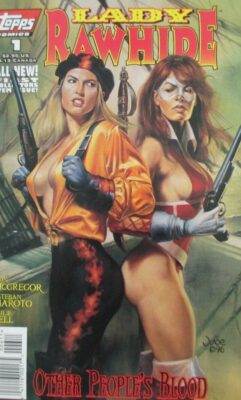
Jim: I’m going to pay you a big compliment on this. In that, I think that ultimately this is a work that is talking about war and the aspects of war in the same way that (Harvey) Kurtzman explored the Korean war during Two-Fisted Tales in those. And I wondered, was that ultimately, was this Vietnam War influenced? Because this was about the horrors of that kind of combat, and the effect it has on people.
McGregor: It’s definitely about war. But with that, so is War of the Worlds, which is the reason why later on I got to work… When I was going to do Detectives Inc., the original story that Alex (Simmons) drew back in 1969… I had written two Detectives Inc. stories. Alex was going to start drawing the second one, I don’t remember how we got sidetracked, and it didn’t happen. But I bring it up because there were two storylines in those first two stores.
One, Denning has to shoot a kid to save Denning and Rainier’s life, but in 1969 version, it’s dealing with the South Bronx gangs and they’re in a rooftop of the South Bronx. The second story was about the Vietnam War called The Night They Died. When I finally got the chance to do Detectives Inc. again, the first story, we really dealt with college campus riots. Well, I guess it was 1979, 1980 when I wrote the first Detectives Inc., nothing was going on in the college campuses, so it no longer interested me to write about it.
And that became the story where they were up at the South Bronx, because I really wanted a sequence that would be so emotional and devastating, and I wanted the idea to explore that… A lot of times in comics, when people have to kill somebody, they don’t have to live with the killing. And it brought such a humanity to Denning’s character because Rainier had so much going on, his personal life is such in shambles.
The second storyline, like I said, originally it was going to be about the Vietnam War, but now I’d just come off of Killraven, the Black Panther, and even Sabre… Whilst Sabre deals, maybe even more specifically with war, at some extent. Although the plotline is like set in 2020, remembering that I wrote it in 1977, and that book almost didn’t get finished because it was so controversial.
McGregor: But in going to Detectives Inc. I thought on the second storyline, would be the murder of a woman who’s gay, on a beach up in the… I suddenly forgot the name of the park…
[00:50:00]
Anyway, but every place is actually real. All the scenes that are… On Sunken Meadow Park, that’s where that takes place. I actually worked that all out, physically went out there and enacted the entire crime scene, so I would know exactly where everything was. I could take pictures of everything, and Marshall Rogers would have exact representation of what that place look like.
But it seemed to me, that was something more than I wanted to write about because I couldn’t do gay characters at Marvel at that time. If I’d ever come out with Venomm at that point in time, that would have been my last book. I would just have pushed them too much, too fast, too quick. It wasn’t going to see print. So, when I got to do Detectives Inc., the major restriction was that was 46 pages of story, and that’s it. That was set in stone. But within that 46 pages, I could do anything I wanted. And I’m still proud of what we did with that book. The kind of work that Marshall Rogers, put into it. The kind of storytelling we did, but that we were able to do gay characters who were very human, and put it in a very empathic storyline.
One of my favorite reviews I’ve ever gotten was from a gay writer who realized, because most critics don’t understand the things that limit you. I had 46 pages and tried to tell a story convincingly, then you could take Rainier, who basically had only stereotype in his mind for lesbians and turned him into somebody who now really kind of has a friendship with this woman and understands her pain, and what she’s been through. So, I’m really glad to this day that we get to do that story.
Jim: I read what Dwayne McDuffie said about Jungle Action and Panther’s Rage. Can you talk about that a little bit? How important it was to him?
McGregor: Oh, how important it was to me that he wrote it. I mean that Dwayne McDuffie, this guy is so talented. One of the best men I’ve ever met in my life. When he wrote the original piece, I think Dwayne wrote it… He had a blog page. But I don’t know if that’s where it first appeared on that or it was a version of it. And somehow, I had become aware of it. So, when are we going to do the Masterworks, and add all these features, and Cory Sedlmeier was really great, kept his word to me and said, “If I do the introduction, I’m not going to gloss over all the problems that we had to make this book a reality.” And Corey was very much supportive of that and left the introduction long before, so we’re able…
He came over more than once to get material for the back of the book, so we could do these DVD type extras of stuff that; artworks that you’ve never seen, script pages, the backs of the envelopes and stuff where you could see notes and how things… You could really kind of get an evolution of behind the scenes of what help shape to put this material together. So, while that was being done…
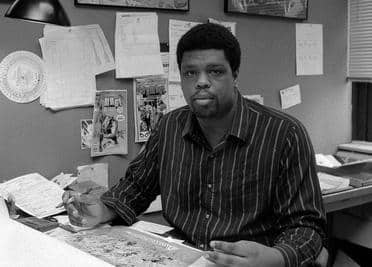
McGregor: By this time, Dwayne and I were friends and knew each other. So, I called and asked Dwayne, if it would be alright if we used his piece for the Marvel Masterworks book on Panther’s Rage and a lot of the Jungle Action Black Panthers. And he said yes, but he wanted to rewrite it. I said, “No, you don’t have to do anything.” He just said, “No, no, you can use it if you let me rewrite it. I wrote about other the writers in there.” I said, “Dwayne, my ego can take it. That’s fine. Keep everything you’ve done. I’m not…” He said, “No. I want to write a piece on those books.” I said, “Dwayne, whatever you want, do it.”
So, I had not actually seen the finished piece, and when the book came out, Marvel had not sent me a copy. I had worked with Corey, I had read the introduction that I wrote to go over because Corey gave me access to that, but I didn’t know what the book looked like.
On the day it came out, my daughter was coming to see me, by train from Pennsylvania. She was in Pennsylvania at the time, so the entire family was coming in… I got a feeling this was maybe around the holiday… So, I was going to go down to Penn station to pick them up and I said, “Oh, I’ll stop off at this kind of book store on 14th Street, which is just about six blocks walk from Penn station. I’ll stop in, I just wanted to see what the book looked like. And I couldn’t because they had it sealed in plastic.
So, I had to go buy my own book and I was walking down the sidewalk toward Penn station to meet my daughter… I don’t look at the stuff that I did. I’m reading Dwayne’s piece. I had tears in my eyes by the time I was done then. He was so kind to me, and that the books meant so much to him. That’s somebody that talented and have such strong feelings about it.
Jim: It’s a beautiful piece. I mean, it really is lovely to read.
McGregor: Yes, it is. I’ve been very fortunate. A lot of the readers, thank God for the readers. Thank God for Dwayne. I mean I miss him every day. I was actually working with Dwayne… The problem that you guys see right now, I was having… It was a different version of this, where I was almost getting sick every day and I was waking up with the taste of blood in my mouth every day.
[00:55:00]
So, I guess, it gives you an idea of how I really didn’t know whether my days were numbered or what exactly, how this all going to play out, because the doctors weren’t able to figure out what was causing all of it and I remember telling Dwayne… I hadn’t yet met his wife, Charlotte. Charlotte was supposed to join us that night. We were meeting at a restaurant in Manhattan, and I remember saying to Dwayne, “Don’t let these motherfuckers rewrite history, Dwayne. You know what was going on in the timeframe these books were being done.” I’d never had… Dwayne was much younger than I am, and I surely didn’t think that I was going to outlast him. And I thought if there’s one person I would entrust with the history of that, it would be Dwayne.
When Dwayne died, I was working on the Ben 10 for him. I had been in California. I’ve been invited to Robert Culp’s memorial service. You asked about people who influenced me. Certainly, Robert Culp is one of them. I can’t imagine who I would be without I Spy. I don’t… The kid from Rhode Island, growing up, could never have imagined that he would get to know Robert Culp. And that we would actually spend time together. In fact, he wanted me to adapt one of his scripts into comics like… Bob… He wanted Gene Colan to draw because he loved Gene Colan’s artwork, and so did I.
Jim: Well I’ve never heard this. He was really into comics?
McGregor: Oh, Robert Culp’s totally in to comics. So, that’s why the Nathaniel Dusk is dedicated to him. There’s a couple of episodes of I Spy that if you know anything about pop culture back in that time in the ‘50s and ‘60s, especially with movies, maybe even TV shows, if they used it, if somebody was seeing you reading comics, that was an indication, virtually, that the person was slow-minded, that they weren’t, you know…

Jim: Yes.
McGregor: It was like a shorthand that movies used, ”Okay, this person”, you know, “Look, he’s reading a comics. How dumb is he? He can’t be smart.” By then, I Spy is a couple of episodes, I know one is I think called Sparrowhawk, they’re in Las Vegas and they’re sitting around poolside, by a hotel pool, and they’re reading comics. There’s another one, they’re reading comics as well. So, in one, Bob is reading Dick Tracy and another, I think he’s reading a Charlton comic called Konga.
I said to him, “Bob, Konga? What the hell? You’re out here reading Konga!… Okay. Whatever you say.” But yeah, he was a big Terry and the Pirates fan. That was like his favorite comic of all time. And I managed to get him some Terry before Dean Mullaney went into these superlative editions of Terry and the Pirates.
He wrote a screenplay. He was actually actively… He had just sent me the screenplay for Terry and the Pirates. I can’t believe it Robert Culp had called and said to me, “Don, would you read this over for me, and give me notes?” You’re Robert Culp. What do you mean give you notes? Like anything you want to do, as far as I’m concerned, is fine.
So yeah, I really appreciated him… [inaudible]
Jim: Oh, that’s fascinating. So, when he’s doing Greatest American Hero, he’s totally into comics and has a sense of all of that, doesn’t he?
McGregor: Yes. Oh, absolutely… Absolutely.
Jim: I’ll never watch that show with the same… Now, I have a new perspective. That’s fantastic. I’m gonna finish up with Panther’s Rage. But I wanted to ask you about one issue, and this is an indulgence, but I’m going to take it. There was that issue with the dinosaurs in the pit. And the character, I can’t recall his name, but he’s kind of a mystical, mythical sprite of some kind, and in it with the bird finally dying in the tarpits.
Jim: Is there a connection between the bird and the sprite? Because he disappears when the bird dies. And I just wanted to say that’s one of the most poetic issue also… I said what my favorite scene was, but that’s an issue that I love. You’re always poetic, but that one especially, just held up incredibly well for me. And I wondered if what your thoughts were on that issue especially.
McGregor: Okay. Number one, somebody wrote a really incredibly in-depth piece on that particular scene you’re talking about, but to be honest with you, that type of question there is no answer to, for me. I really believe what you find in that scene, that’s for you to determine if you have to explain what it means to the person, you are really taking away any power it might have in the way that it speaks to a person. That’s the most answers that I can give you in terms of, I’m not going to tell you what you should be thinking about that either. You know what you feel, you know what your experience is. What I’m hoping is that will be a sequence that people just respond to, and they relate to it, and it says this to them. It won’t always say the same thing to everybody.
I remember John Warner told me, that with the last issue of Killraven, The Morning After Mourning Prey, because many people still analyze what that book’s about. “You have to be listening”, and he has a certain piece of music that he would play every time he read it. “You have to be listening to this music to really understand that piece.” I said, “John, whatever works for you. If that’s what you need. Then that’s what you should do. And if it brings you enjoyment and at the same time it gives you a sense of meaning that you didn’t have before, then I’m all for it.”
[01:00:08]
So, I’m glad you feel that it was poetic, and that it spoke to you on that level… It’s just amazing to me that the books we’re talking about right now, they’re over 40 years old, and the fact that so many people still come up to me and they know exactly where they were when they read a particular book, what impact it had to them, what it said to them.
And I don’t know why it should surprise me because I have my own stuff. I think about certain things, like Buddwing, or See Them Die, or like Steve Carella dying. I know exactly where I was, particular books, and what it meant to me. And that I don’t know who I would be if those books, that movie, those TV series weren’t part of my life. So, it all depends on how you relate to it individually.
The only thing I hope is that when people started to read one of the books that they would start reading it and say, “Oh, this is just another comic that I’m going to plough through and I’m just going to throw it on the pile. And I’m onto the next one.” I was hoping that some people would get something from it and go, “Oh, wait a minute, let me go back. I need to pay attention here. This isn’t just another comic to get through for the month and then get to next week’s comics.” I hoped it would be something.
The storyteller can’t really ask for much more than that. That there are people out there that care so passionately about these stories that relate to them so much, and been able to relay that to me over the years. I mean it’s just…
Jim: You instilled a love of comics in me. That is why I’m 60 years old and I’m talking to you today about comics.
McGregor: Oh, that’s why I’m 74 with a voice that can hardly talk and I’m talking to you and even though I’m… I really appreciate what you guys do because once the history of these things are lost, it’s gone.
Advertisement
Alex: Yeah, that’s true.
McGregor: If I could do something to help… Like when Rich died, I was with his widow, Mila. And Mila was crying, one time I was with her and, “Please don’t let them forget Rich, Don. Please don’t let them forget Rich.”
“Not as long as I’m alive, Mila.” And if you notice, if you’re on my Facebook page or you’d go up on the DonMcGregor.com website, you’ll see, it’s like I’m very, very, very fortunate. Before we end this, let me say, not only do I get to work with Tom Sutton, and Rich Buckler, and Craig Russell, and Billy Graham, but then down the line I get to work with… With Jose Ortiz, and Esteban Maroto, and Mike Mayhew, and Dwayne Turner. I, Dwayne and Mike became really best friends. Like a lot of the others… Gene Colan. I love Gene dearly.
At one point, I saw Gene… I went to the hospice the day before he died, I guess. And I spent the day with him and into night, because I got incredibly lost coming back, trying to get back into Brooklyn again. I got so lost, I was for hours lost, in Brooklyn. But I spent hours sitting with Gene. At first, I was sitting in a chair and we’re talking and Gene still had a question even when he was a day away from dying, that I quoted a line to him.
Like I can’t quote my own material but I can create other writers. And I remember like telling him a line from like Buddwing that I’ve always loved. “I’m tired of people looking at me and seeing only of themselves. When you look at me, you see me, but you see nothing. Nothing at all.” He says, “Write that down, Don. Write that down.” He wanted me…
I take a T.S. Elliot poem. “We shall never cease from exploration, but the end of all our exploring will be to return where we first started. But to know the place for the first time.” And here’s was Gene, only has a day of his… “Don, write that stuff down for me, so I can study that stuff tonight.”
For last two hours, I guess, we were together. I just sat on the edge of the bed with him and Gene has these huge, large, incredibly strong hands, and we just held hands, I sat on the bed, and I quoted things to him and told stories back and forth.
Oh, I could tell you a quick Gene Colan story.
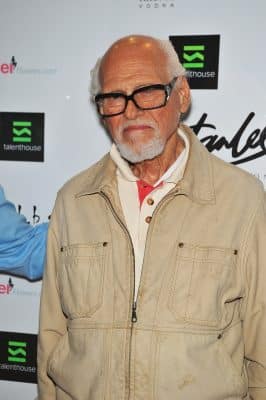
Jim: Yes please.
McGregor: The first thing Gene and I ever worked on together was Killraven, Something Worth Dying For. And later on, I did Hodiah Twist story called The Hero-Killer Principle! and that was much later. I don’t know how many years later, but at least four or five years.
Jim: Four years later. Four years because ‘74 is the Amazing Adventures #26 and the other was 78.
McGregor: Okay… You guys know all this stuff better than me. I knew it was sometime later, because for Gene… One time we’re talking, I’m with his wife, Adrian. Adrian is going, “Gene never, he never talks to me about the stories he’s drawing.” But he’s stopping about every person, and he’s saying, “Hey, look what’s happening now. Look, it’s happening now.”
[01:05:02]
And I think it was just the kind of story that Gene really, really liked. And so, one day I’m talking to Gene and I go to Gene… “Yeah, you drew the Serpent Stallion in such a… You really captured the Serpent Stallion exactly what I want you to do. You understood everything. It’s like you were inside my head Gene. Then Gene goes like, “Serpent Stallion?” “Yeah. You know, in Killraven” “What’s Killraven?” “When you and I worked together on the Killraven thing.” Then he goes, “We worked on the Killraven?” “Yeah, Gene. You even drew Camilla Frost nude. Do you remember? And then they had the Serpent…
[chuckles]
“Serpent Stallion? Don…” So, Gene never… And he goes, “The first story we ever worked on was Hodiah Twist.” And I say, “It’s not, Gene. I swear to God it’s Killraven.”
At some point in time, because Gene and I worked together a lot, at the end of his life he was living fairly close to where I was. So, I would try to stop and see him once a week, or once I knew he was there. In the beginning, I had no idea he was living that close to me.
One time, he had to have dental surgery and I said, “Gene, I’ll take you there.” And we’re driving to someplace in Brooklyn, and if you know anything about living in this city, like wherever there’s doctor’s places, or a dentist place, there’s no place for you to park. It’s like crowded, and I had to find a place to park, and Gene was saying, “Okay, Don, I’m going to go and have this thing cut out. I’ll get a car service home.”
“Don’t Gene, you’re not going into have surgery and be alone. I’m going to find a place to park this car and I’m going to go wait for you.” He goes, “No, Don. You don’t have… I said “Gene, you could ask a lot more of me than this.” I love Gene Colan. I love working with him, and I feel profoundly privileged that I got to be a part of his life. And I told his daughter, Nancy, “As long as I’m around, nobody’s going to forget your dad.”
I just feel there’s a real… It’s a necessity. I’ve told Billy Graham’s granddaughter, Shawna… Again, Billy is such a part of my life. And right down to when I was going to do the Ku Klux Klan stuff and Billy got the press grip. He called me up. He goes, “Don, are you sure you want to do this?” I said, “Yeah, want to do this. Yeah.” He said, “Hey listen, Don, I’m up here in Harlem. The Klan isn’t coming up here to get me. You’re living out in Queens. Are you sure you want to do this?” And I’m joking with Billy, and I say something like, “Oh, come on Billy. They can take a joke, can’t they?”
[chuckle]
McGregor: I can still hear Billy’s tone of voice now… “No, they can’t, Don. They can’t.” That’s part of just the friendship Billy and I… I still remember the very last phone call that we had together, with that being safe as Sabre, The Exploitation of Everything Dear. That will have my last lines that I remember to this day. Because Billy said it’s something that he didn’t have to do… And we didn’t have no idea at the time that it would be the last time he and I never would talk again.
Alex: Well, this has been awesome, Don. We’ve had a great time listening to your personal history of your life as well as your life in comics on the Comic Book Historians Podcast with Alex Grant and Jim Thompson.
[01:08:05]
© 2020 Comic Book Historians
